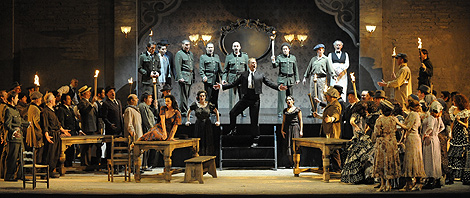BIOGRAFÍA: Alessandro Camera

Alessandro Camera came to be active in the field of opera while still completing his studies at the Accademia di Belle Arti di Brera, when he worked with Luciano Damiani. During the early stage of his career, he was involved in the making of productions of Igor Stravinsky’s
The Fairy’s Kiss (La Scala, Milan), Verdi’s
La traviata (The Arena in Verona and the Salzburg Festival), and Berlioz’s
La Damnation de Faust (Staatstheater Stuttgart). His designs for drama productions included Euripides’
Hecuba and
The Bacchae, conceived as classical stagings for the open-air Greek theatre at Syracuse, Sicily; as well as various experimental projects, again in partnership with Damiani, for Rome’s Teatro di Documenti. Alessandro Camera’s other notable commitments have included set designs for productions of Ingmar Bergman’s
Scenes from a Marriage at Rome’s Teatro Piccolo Eliseo (directed by Gabriele Lavia), Flaubert’s
Madame Bovary, with Monica Guerritore, and Schiller’s
Mary Stuart (both at Rome’s Teatro Eliseo, directed by Giancarlo Sepe). Working with the director Glauco Mauri, he designed sets for productions of E. E. Schmitt’s
Enigma Variations; Ben Jonson’s
Volpone; Goldoni’s
The Liar; and Dostoevsky’s
Crime and Punishment. In cinema, he worked with Ezio Frigerio on the film,
Le Hussard sur le toît, directed by Jean-Paul Rappeneau (1995).
The year 1997 marked the beginning of his intensive collaboration with William Orlandi. At Paris’ Opéra Bastille the two worked together on Massenet’s
Don Quichotte and Prokofiev’s
Love for Three Oranges, both directed by Gilbert Deflo. Also in tandem with Orlandi, there followed set designs for Monteverdi’s
Orfeo and Tchaikovsky’s
The Queen of Spades, both for Barcelona’s Gran Teatre del Liceu; Mascagni’s
Cavalleria rusticana, Massenet’s
Thérese, and Ponchielli’s
La Gioconda at Zurich’s Opernhaus; Rossini’s
Semiramis for the Rossini Opera Festival at Pesaro, Italy; Meyerbeer’s
Les Huguenots; Verdi’s
Luisa Miller (at the Nationale Reisopera in Enschede, and the Teatro La Fenice in Venice, respectively);
Rigoletto (Lausanne Opera); and
Le Roi de Lahore by Massenet (Teatro La Fenice), directed by
Arnaud Bernard. He is currently busy creating set designs for the production of Verdi’s
Falstaff which will be inaugurating the 2006/07 season at the Teatro San Carlo in Naples.
Fuente: Statni Opera y Opera de Lausanne.
CARMEN
Opéra-comique en cuatro actos. Música: Georges Bizet. Libreto: Henri Meilhac y Ludovic Halévy, basado en la novela homónima de Prosper Mérimée. Estrenada en París, Opéra Comique el 3 de marzo de 1875.



Palacio Euskalduna. Bilbao, 17 de Febrero de 2009.
Carmen: Natascha Petrinsky. Don José: Marco Berti. Micaëla: Latonia Moore. Escamillo: Teddy Tahu Rhodes. Le Dancaïre: Manel Esteve. Frasquita: Gladys Rossi. Mercédès: Nuria Lorenzo. Le Remendado: Jon Plazaola. Zuniga: Nicolas Testé. Moralès: Javier Galán.
Producción Finnish National Opera. Director Musical: Patrick Davin. Director de Escena: Arnaud Bernard. Escenógrafo: Alessandro Camera. Figurinista: Carla Ricotti. Iluminador: Patrick Méeüs. Bilbao Orkestra Sinfonikoa. Coro de Ópera de Bilbao (Director: Boris Dujin). Coro del Conservatorio de la Sociedad Coral de Bilbao (Director: José Luis Ormazabal)






Más info
aquí, y
aquí.
RIGOLETTO
Première représentation à Venise, Teatro La Fenice, le 11 mars 1851

Il duca di Mantova
Giuseppe Filianoti (les 25 et 28/9)
Robert Nagy (le 30/9, les 2 et 5/10)
Rigoletto
Carlos Almaguer
Gilda
Nicoleta Ardelean
Sparafucile
Jean Teitgen
Giovanna/Maddalena
Isabelle Henriquez
Il conte di Monterone
Ruben Amoretti
Marullo
Vincent Deliau
Matteo Borsa
Jose Luis Sola
Il conte di Ceprano
Francesco Biamonte
La contessa
Pauline Sabatier
Il paggio
Nathalie Constantin
L'huissier
Juan Etchepareborda
Direction musicale
Paolo Arrivabeni
Mise en scène
Arnaud Bernard
Décors
Alessandro Camera
Costumes
Katia Duflot
Lumière
Patrick Méeüs
Chef de chœur
Véronique Carrot
Orchestre de Chambre de Lausanne
Choeur de l'Opéra de Lausanne














































